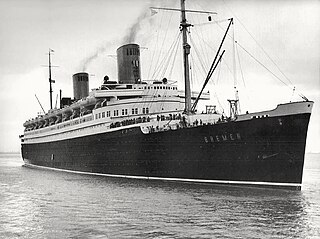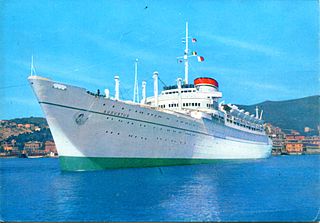
The Blue Riband is an unofficial accolade given to the passenger liner crossing the Atlantic Ocean in regular service with the record highest average speed. The term was borrowed from horse racing and was not widely used until after 1910. The record is based on average speed rather than passage time because ships follow different routes. Also, eastbound and westbound speed records are reckoned separately, as the more difficult westbound record voyage, against the Gulf Stream and the prevailing weather systems, typically results in lower average speeds.

An ocean liner is a type of passenger ship primarily used for transportation across seas or oceans. Ocean liners may also carry cargo or mail, and may sometimes be used for other purposes. Only one ocean liner remains in service today.

SS Bremen was a German-built ocean liner constructed for the Norddeutscher Lloyd line (NDL) to work the transatlantic sea route. Launched in 1928, Bremen was notable for her high-speed engines and low, streamlined profile. At the time of her construction, she and her sister ship Europa were the two most advanced high-speed steam turbine ocean liners of their day. The German pair sparked an international competition in the building of large, fast, luxurious ocean liners that were national symbols and points of prestige during the pre-war years of the 1930s. She held the Blue Riband, and was the fourth ship of NDL to carry the name Bremen.

SS Europa, later SS Liberté IMO 5607332, was a German ocean liner built for the Norddeutsche Lloyd line (NDL) to work the transatlantic sea route. Launched in 1928, she and her sister ship, Bremen, were the two most advanced, high-speed steam turbine ocean vessels in their day, with both earning the Blue Riband.

SS Conte di Savoia was an Italian ocean liner built in 1932 at the Cantieri Riuniti dell'Adriatico, Trieste.

SS Cristoforo Colombo was an Italian ocean liner built in the 1950s, sister ship of the SS Andrea Doria.
Norddeutscher Lloyd was a German shipping company. It was founded by Hermann Henrich Meier and Eduard Crüsemann in Bremen on 20 February 1857. It developed into one of the most important German shipping companies of the late 19th and early 20th centuries, and was instrumental in the economic development of Bremen and Bremerhaven. On 1 September 1970, the company merged with Hamburg America Line (HAPAG) to form Hapag-Lloyd AG.

Peroni Brewery is a brewing company founded by Francesco Peroni in Vigevano, Italy, in 1846.
Italian Line and from 1992 Italia Line, whose official name was Italia di Navigazione S.p.A., was a passenger shipping line that operated regular transatlantic services between Italy and the United States, and Italy and South America. During the late 1960s the company turned to running cruises, and from 1981 it became a global freight operator.

SS Raffaello was an Italian ocean liner built in the early 1960s for Italian Line by the Cantieri Riuniti dell'Adriatico, Trieste. It was one of the last ships to be built primarily for liner service across the North Atlantic. Her sister ship was SS Michelangelo.

SS Vaterland was a transatlantic ocean liner that was launched for the Hamburg America Line in 1940 but left incomplete because of the Second World War. An Allied air raid damaged her in 1943, and she was scrapped in 1948.

SS Giulio Cesare was a liner of the Navigazione Generale Italiana, which was later operated by the Italian Line. The ship was used to transport first class, second class, and tourist-class passengers.

Conte Verde was an Italian ocean liner active in the early 20th century.
The Blue Riband is an accolade given to the passenger ship that held the fastest record for transatlantic crossing.
Cantieri Riuniti dell'Adriatico was an Italian manufacturer in the sea and air industry which was active from 1930 to 1966. This shipyard is now owned by Fincantieri.

SS Leonardo da Vinci was an ocean liner built in 1960 by Ansaldo Shipyards, Italy for the Italian Line as a replacement for their SS Andrea Doria that had been lost in 1956. She was initially used in transatlantic service alongside SS Cristoforo Colombo, and primarily for cruising after the delivery of the new SS Michelangelo and SS Raffaello in 1965. In 1976 the Leonardo da Vinci became the last Italian Line passenger liner to be used in service across the North Atlantic. Between 1977 and 1978 she was used as a cruise ship by Italia Crociere but was laid up from 1978 onwards until 1982 when she was scrapped.

MS Stockholm was the name of two near-identical ocean liners built by Cantieri Riuniti dell' Adriatico, Monfalcone, Italy between 1936 and 1941 for the Swedish American Line. Neither of the ships entered service for the company that had ordered them—the first ship was entirely destroyed by fire during construction in 1938, while the second was completed in 1941 but immediately sold to the Italian government as a troopship. The second ship served for three years in the Regia Marina and Kriegsmarine under the name MS Sabaudia, until sunk by British bombers outside Trieste in 1944. It is unknown if she was ever actually used as a troopship.

MS Augustus was a 27,090 GRT, luxury ocean liner built in 1950 for Italian Line. She was the sister ship to MS Giulio Cesare that was launched in the same year. These two ships were built to the same design, with similar specifications. After the Augustus was sold to Hong Kong, she sailed under five names. The ship was later sold to Manila Hotel and renamed MS Philippines, functioning as a static hotel. As reported by both Maritimematters, and maritime, the MS Philippines was sold for scrap in September 2011. As of December 2011, she was beached in Alang for scrapping.

MS Giulio Cesare was a luxurious ocean liner built for the Italian Line. She was a sister ship to MS Augustus which was launched in the same year. She was built for the South America service like her sister. These two ships' specification and design were very similar.
No. 272 Squadron RAF was a Royal Air Force Squadron formed as an anti–submarine unit in World War I and a coastal fighter unit in World War II.



















